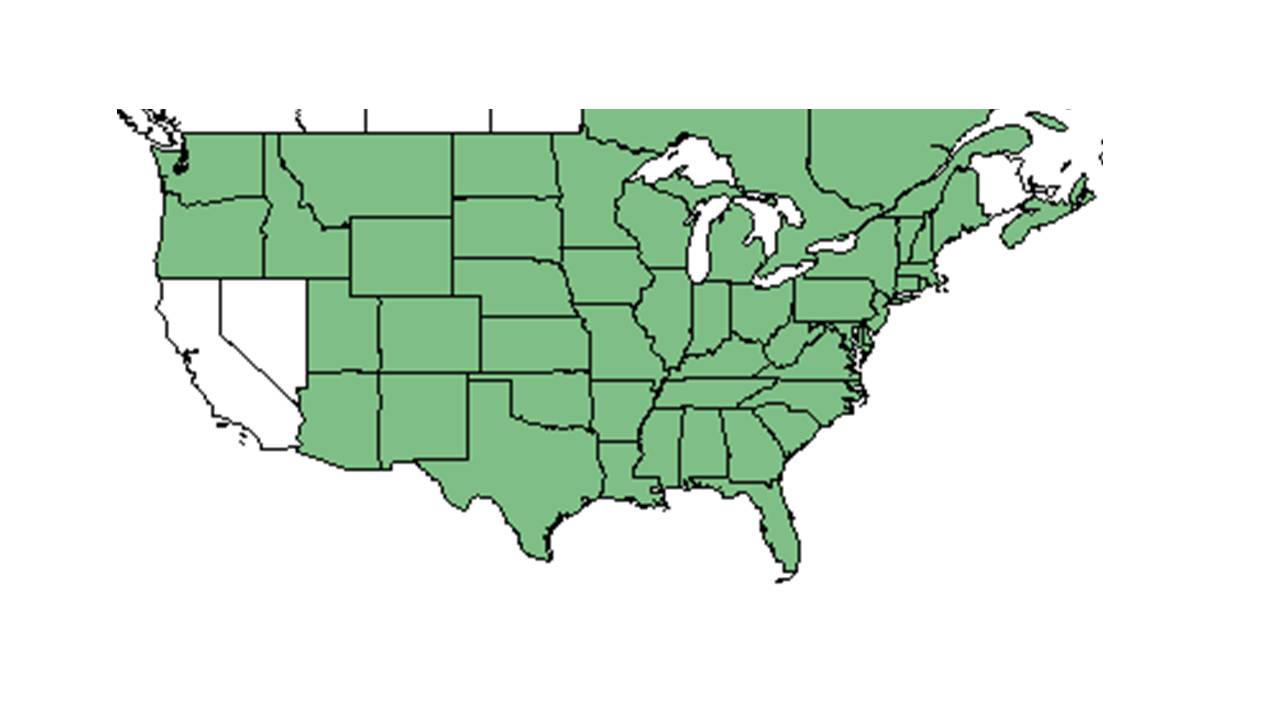Difference between revisions of "Physalis heterophylla"
(→Conservation and Management) |
Krobertson (talk | contribs) |
||
| Line 30: | Line 30: | ||
==Ecology== | ==Ecology== | ||
===Habitat=== <!--Natural communities, human disturbed habitats, topography, hydrology, soils, light, fire regime requirements for removal of competition, etc.--> | ===Habitat=== <!--Natural communities, human disturbed habitats, topography, hydrology, soils, light, fire regime requirements for removal of competition, etc.--> | ||
| − | ''P. heterophylla'' has been documented to grow in calcareous coastal hardwood hammocks, drying sand bordering woods, upland sandhills and annually burned longleaf pineland | + | ''P. heterophylla'' has been documented to grow in calcareous coastal hardwood hammocks, drying sand bordering woods, upland sandhills and annually burned longleaf pineland. <ref name="FSU Herbarium">Florida State University Robert K. Godfrey Herbarium database. URL: [http://herbarium.bio.fsu.edu http://herbarium.bio.fsu.edu]. Last accessed: July 2015. Collectors: Loran C. Anderson, Andre F. Clewell, R. F. Doren, R. Komarek, J. M. Kane, Lisa Keppner. States and Counties:Florida: Calhoun, Leon, Nassau, Wakulla, Washington. Georgia: Thomas. Compiled by Tall Timbers Research Station and Land Conservancy.</ref> It has also been observed growing in old biocontrol plots and a fallow quail food patch. It has been documented in moist sandy loam and in the loam soils of the Red Hills Region. <ref name="FSU Herbarium"/> Associated species include longleaf pine. <ref name="FSU Herbarium"/> |
===Phenology=== <!--Timing off flowering, fruiting, seed dispersal, and environmental triggers. Cite PanFlora website if appropriate: http://www.gilnelson.com/PanFlora/--> | ===Phenology=== <!--Timing off flowering, fruiting, seed dispersal, and environmental triggers. Cite PanFlora website if appropriate: http://www.gilnelson.com/PanFlora/--> | ||
| − | ''P. heterophylla'' has been observed to bloom May through July | + | ''P. heterophylla'' has been observed to bloom May through July. <ref name="FSU Herbarium"/> |
===Seed dispersal=== | ===Seed dispersal=== | ||
According to Kay Kirkman, a plant ecologist, this species disperses by being consumed by vertebrates (being assumed). <ref name="KK"> Kay Kirkman, unpublished data, 2015. </ref> | According to Kay Kirkman, a plant ecologist, this species disperses by being consumed by vertebrates (being assumed). <ref name="KK"> Kay Kirkman, unpublished data, 2015. </ref> | ||
| Line 50: | Line 50: | ||
==References and notes== | ==References and notes== | ||
| − | |||
| − | |||
Revision as of 18:06, 5 August 2016
| Physalis heterophylla | |
|---|---|

| |
| Photo by Ohio State Weed Lab, The Ohio State University, Bugwood.org | |
| Scientific classification | |
| Kingdom: | Plantae |
| Division: | Magnoliophyta - Flowering plants |
| Class: | Magnoliopsida – Dicotyledons |
| Order: | Solanales |
| Family: | Solanaceae |
| Genus: | Physalis |
| Species: | P. heterophylla |
| Binomial name | |
| Physalis heterophylla Nees | |

| |
| Natural range of Physalis heterophylla from USDA NRCS Plants Database. | |
Common name: clammy groundcherry
Contents
Taxonomic notes
Synonyms: Physalis heterophylla var. heterophylla; P. heterophylla var. ambigua (A. Gray) Rydberg; P. heterophylla var. clavipes Fernald; P. heterophylla var. nyctaginea (Dunal) Rydberg; P. ambigua (A. Gray) Britton; P. nyctaginea Dunal
Description
"Annual or perennial, glabrous or pubescent herbs. Leaves petiolate, entire to coarsely dentate, the base tapered, subcordate or oblique. Flower axillary, solitary; the calyx tube expanding, papery and bluntly conical when mature, loosely enclosing the fruit. Corolla campanulate to subrotate, yellow, often with 5 dark spots in the base of the tube; stamens 5, erect, separate, anther yellow or blue, dehiscing by lateral slits berry somewhat mealy, 2-locular, globose." [1]
"Rhizomatous, often viscid perennial 2-9 dm tall. Stem pubescence of glandular trichomes mixed with both long and short nonglandular trichomes. Leaves widely ovate or oblanceolate to triangular or lanceolate, 3-11 cm long, 3-8 cm wide, sinuate-dentate or coarsely and irregularly dentate, rarely subentire, weakly cordate. Calyx 7-12 mm long, lobes triangular to lanceolate, shorter than the tube; corolla 10-18 mm long or broad, with 5 brownish basal spots; anthers yellow or rarely bluish, 3.5-4.5 mm long. Berry ca. 10 mm in diam., the fruiting calyx 2.5-3 cm long, about as broad." [1]
Distribution
Ecology
Habitat
P. heterophylla has been documented to grow in calcareous coastal hardwood hammocks, drying sand bordering woods, upland sandhills and annually burned longleaf pineland. [2] It has also been observed growing in old biocontrol plots and a fallow quail food patch. It has been documented in moist sandy loam and in the loam soils of the Red Hills Region. [2] Associated species include longleaf pine. [2]
Phenology
P. heterophylla has been observed to bloom May through July. [2]
Seed dispersal
According to Kay Kirkman, a plant ecologist, this species disperses by being consumed by vertebrates (being assumed). [3]
Conservation and management
Cultivation and restoration
Photo Gallery
References and notes
- ↑ 1.0 1.1 Radford, Albert E., Harry E. Ahles, and C. Ritchie Bell. Manual of the Vascular Flora of the Carolinas. 1964, 1968. The University of North Carolina Press. 927. Print.
- ↑ 2.0 2.1 2.2 2.3 Florida State University Robert K. Godfrey Herbarium database. URL: http://herbarium.bio.fsu.edu. Last accessed: July 2015. Collectors: Loran C. Anderson, Andre F. Clewell, R. F. Doren, R. Komarek, J. M. Kane, Lisa Keppner. States and Counties:Florida: Calhoun, Leon, Nassau, Wakulla, Washington. Georgia: Thomas. Compiled by Tall Timbers Research Station and Land Conservancy.
- ↑ Kay Kirkman, unpublished data, 2015.